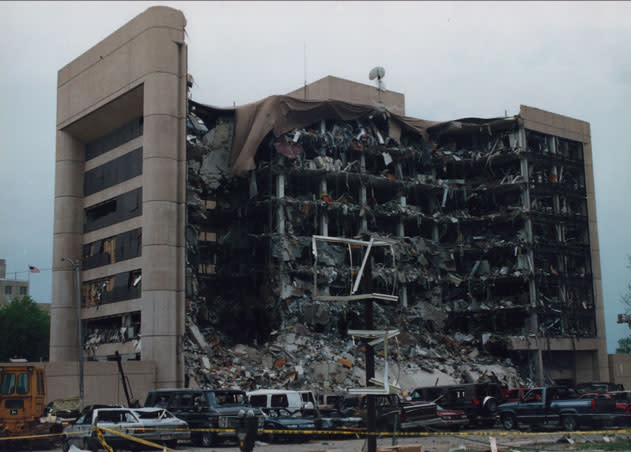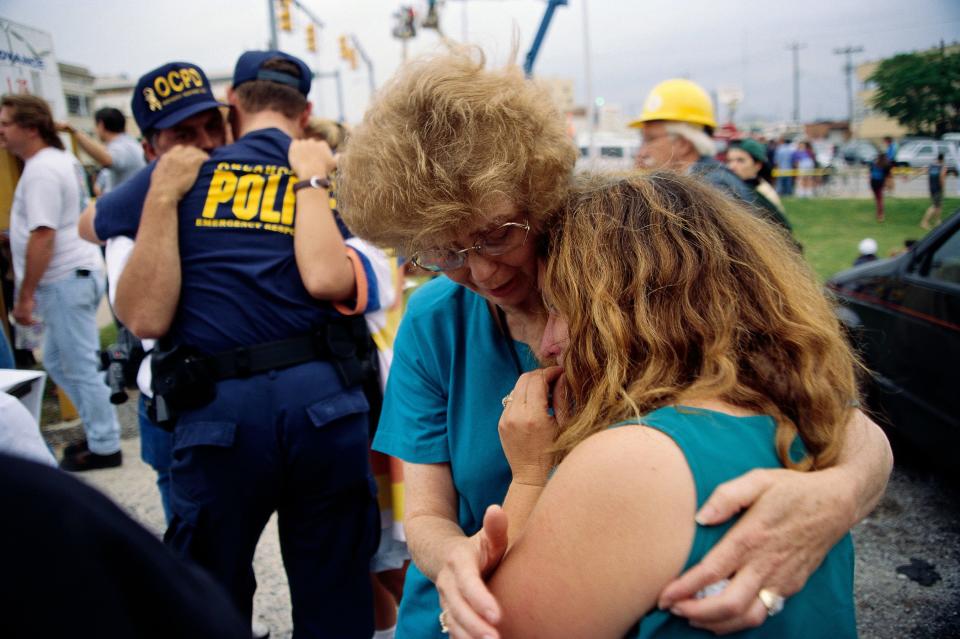Remembering Lives Lost in the Oklahoma City Bombing, 24 Years Later
Ed. Note: Friday marks the 24th anniversary of the bombing of the Alfred P. Murrah Federal Building in Oklahoma City, when a former American soldier and Gulf War veteran, Timothy McVeigh, parked a rented truck carrying a five-ton fertilizer bomb outside the building before walking away.
After the bomb detonated, 168 people died and 680 were injured. Among the dead were 19 children, 15 of whom were in the America’s Kids day care center on the building’s second floor.
McVeigh and his co-conspirator, Terry Nichols, were far-right-wing extremists fueled by rage against the federal government. The attack was a painful eye-opener about the prevalence of domestic terrorism. McVeigh was later executed, and Nichols was sentenced to life in prison.
After the attack, PEOPLE spotlighted the poignant tragedy of the young victims in the day care center. Here is PEOPLE’s cover story from the May 15, 1995 issue.
Of all the victims in the Oklahoma City bombing on April 19, the most pathetic — and the source of the most anguish — are the children, most of whom died in the America’s Kids daycare center. The six-year-old, 13-room facility, housed on the second floor of the Alfred P. Murrah Federal Building, was apparently less than 30 feet from the explosion, and of the three adults and 21 children who were present that morning, only six youngsters survived.

For sales representative A.C. Cooper, 24, and his wife, Dana, 24, who was the director at America’s Kids, the morning began with a regular routine. Around 7 a.m. the couple drove their 2-year-old son Anthony Christopher II to the Murrah Building. He had brought along his new Easter toys Chuckle Bunny and Brown Bunny, but his parents insisted that he leave them in the car when they got to the center. After parking, A.C. had carried in the seven gallons of milk that the kids would be drinking that day. He lingered a few moments at his wife’s desk before heading off to his own job with a hardware service in Oklahoma City. “Dana told Christopher to come give me a hug and kiss goodbye, which he did,” says A.C. “I gave her a kiss and told her that I loved her, and she told me that she loved me.” For A.C. Cooper, this unremarkable parting would become his last memory of his wife and child.
Around 8 a.m. the other children began arriving. Dana served them breakfast of milk and muffins as each sat in an assigned seat in the main room. “This was the time that Dana encouraged the children to learn social skills,” says A.C. One little boy, Eric Lacy, 1-1/2, had arrived early and had already been picked up and taken to another school. By 8:30 the rest of the kids were ready for playtime classes in such things as arts and crafts to begin in the sunlit rooms decorated with their artwork.
Shortly before 9 a.m., Melva Noakes, 43, who had owned the center for only three weeks, phoned Dana to check in. The two were supposed to fly to San Francisco later in the day for a conference on child care, and Noakes was doing the payroll at another center in Choctaw, Okla., 20 miles away. Cooper told her that staffer Brenda Daniels, 42, was with the four youngest kids — 6-month-old Lee Gottshall; Jaci Coyne, 14 months; Tylor Eaves, 8 months; and Antonio Cooper Jr., 6 months — who had been put down for a morning nap in their cribs along the windows overlooking NW 5th Street. Wanda Howell, 34, had nine of the preschoolers in a windowless room at the center of the building, while Cooper herself was supervising seven toddlers, including 1-year-old Baylee Almon, newly released from the hospital after a bout with pneumonia.

For the most part, the same children attended the center each day, making it easy for Cooper and the other staffers to learn their likes, dislikes and habits. Everyone knew that 20-month-old P.J. Allen didn’t like to take a nap after lunch like the other kids. Instead, he preferred to sit down for a second lunch with the adults. (P.J.’s appetite is so huge that staffers had to seat him alongside children who they knew wouldn’t eat their snacks. “That way,” says his grandmother Deloris Watson, 43, “when he was through with his, he’d just finish up for the others.”) While talking to Noakes, Cooper mentioned that Daniels was planning to load six of the children in the cherry- red Bye-Bye Buggy, a low cart, later in the morning for a trip around the building and out onto the patio at the front of the building. Typically the other kids would go into the so-called large muscle room, where they would amuse themselves by climbing or throwing a ball or using the slide.
But soon after Noakes had hung up with Cooper, she felt the shudder of an explosion. “We went outside and saw a jet and thought it must have been a sonic boom,” says Noakes. Of course, it was the bomb. The infants, resting in their cribs, never had a chance. The area in the front of the building where they had been placed took the full force of the gigantic blast caused by 4,800 pounds of fuel-oil-and-fertilizer explosive. (Three of the children in America’s Kids have yet to be found in the rubble. In addition three other kids who happened to be visiting the Murrah building were also killed.) All six of the surviving daycare children, including P.J. Allen, were in the windowless room with Wanda Howell. As for Howell, rescue workers found her dead, holding 2-year-old Dominique London, who had also been killed. For Melva Noakes — who with husband Warren, 45, has been caring for children, either as a foster parent or daycare owner, for 25 years — the grief will never be gone. “We’ve all lost something,” she said sadly last week. “We’re all holding each other’s hands.”


